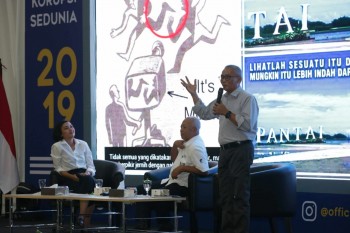
Social media greatly contributes to the development of the digital world. This condition is seen as a challenge as well as opportunity. What do public relations (PR) practitioners need to be aware of?
JAKARTA, PRINDONESIA.CO – According to Wicaksono, a social media expert, there are two of the most fundamental changes that happen in social media. First, the way people act has changed 180 degrees. Second, every individual is now able to act as a content producer. “Like a sudden journalist, they can produce and share any information among other social media users,” he said in front of the participants of the Government Digital Media Festival organized by the Corruption Eradication Commission (KPK) in Jakarta, on Monday (9/12/2019).
Meanwhile, Wicaksono said that the advantage of social media compared to mainstream media is the interaction between the content creator and the audience can happen easily. This is what then makes the existence of mainstream media began to be disrupted.
Another concerning thing is that as many as 65 percents of internet users in Indonesia believe in the truth of the information in cyberspace without first doing a crosscheck. Fake news that is shared massively is possible to be considered true. “This post-truth condition makes PR practitioners, including government PR, have more difficulties in explaining everything,” he said.
Not to mention the various phenomena that occur on social media, such as the circulation of hoaxes, memes, doxing (gathering someone’s personal information to be shared without the owner’s consent), hate speech, persecution, black campaign, to trolls (uploading posts or messages which purpose is to provoke the anger of internet users), participate to be the cause of changes in communication patterns.
Furthermore, people now tend to trust and listen more to information from influencers or key opinion leaders than companies or governments. This condition is a challenge for PR practitioners, especially those who work in the government. “The law of the jungle has collapsed. Now, this is the law of the campfire, namely the people they like will become influencers,” he said.
Beware of Crisis
To avoid a crisis on social media, Wicaksono urged that PR always be alert and appropriate in responding. “The speed in responding is the main key,” he said. As for the technique, first, PR must be able to convince the leader about the importance of crisis guidelines on social media, “Discussions with the leadership aim to equalize perceptions about social media as PR tools,” said the former Editor in Chief of Beritagar.id.
Master the standard operating procedure (SOP) from A to Z before the crisis expands on social media. Furthermore, the social media team must have full authority to manage emerging issues and crises. With notes, they must have a broad understanding, know what really happened, so that they can detect the issues as early as possible. “Not all comments on social media need to be taken seriously,” he said.
Wicaksono continued, in the social media itself, there are two signals, such as quality signal/information and signal in the form of noise (noisy/rowdy). “We have to listen to quality information although it comes from a micro influencer. While noise, we must ignore it although it comes from a mega influencer,” he concluded. (ais)
- OTHERS
- Tracing Ministries and Institutions Communications During the Pandemic
- This is the Strategy to Restore Public Trust During a Pandemic
- The Law of “Campfire” in Social Media
- Understanding Social Media Characteristics for Maximal Use
- Totality in Using Momentum